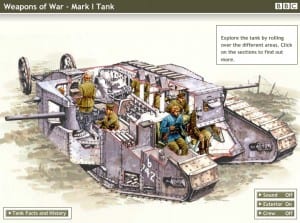When it came to rehearsing our section, now that we had created the caterpillar tracks added some movement, applied some text to the movement, what should we do next? What more could do to give the impression that the audience were seeing a tank from the First World War? After a another trip to the museum of Lincolnshire life and reading more into what it would have been like for the crew inside the tank. The idea that we came up that we should place our audience on the inside of our caterpillar tracks, placing a piece of material over them like a roof and squeezing the audience together to give that Claustrophobic feel that they are inside this killing machine with no way of escape.
The original Tank crew shared the same space as the engine. The environment inside was extremely unpleasant; since there was no ventilation, the atmosphere was contaminated with poisonous carbon monoxide, fuel and oil vapours from the engine, and cordite fumes from the weapons. As you can see from the video it was a claustrophobic space for someone to be in, although they were protected from any outside force, it was the inside that was more deadly. The crew themselves were only issued with leather-and-chainmail masks plus a helmet to protect their head against projections inside the tank. Gas masks were standard issue as well, as they were to all soldiers at this point in the war.
Steering a tank was difficult; it was controlled by varying the speed of the two tracks. Four of the crew, two drivers and two gears men were needed to control the direction and speed. As the noise inside was deafening, the driver, after setting the primary gear box, communicated with the gears men with hand signals, first getting their attention by hitting the engine block with a heavy spanner. For slight turns, the driver could use the steering tail: an enormous contraption dragged behind the tank consisting of two large wheels, each of which could be blocked by pulling a steel cable causing the whole vehicle to slide in the same direction. If the engine stalled, the gears men would use the starting handle – a large crank between the engine and the gearbox. Sadly many of these vehicles broke down in the heat of battle making them an easy target for German gunners.
Now that we had an idea of what we wanted to with the audience, we decide to apply some more text to our piece, this time it was instead of the tank crews motto, we were going use the a newspaper article form the Lincolnshire echo from 1965 entitled ‘Men and Machines’. The article itself was someone opinion on how we now relying on machines to do our fighting instead of an army.
“The improvement in machines far outstrips the improvement in a man as a fighter as so we become more and more mechanized”
Works cited:
www.firstworldwar.com/weaponry/tanks.htm (Accessed 14th April 2013)
www.bbc.co.uk/history/interactive/animations/mark_one_tank/index_embed.shtml (Accessed 19th April 2013)
Linconlshire Echo,Men and Machines,1965
